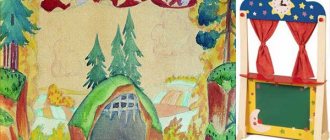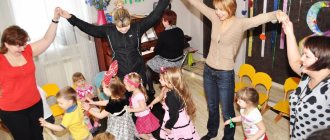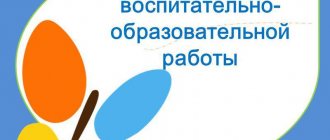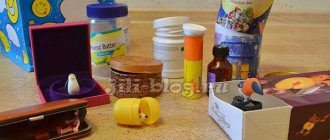Middle group. Junior preschool age. Children 4 - 5 years old
Calendar and thematic planning in the middle group Theme of the week “Bread is the head of everything. The path of bread. Agricultural labor"
.
10/04/2021 Monday Final lesson: Exhibition of children's creativity “Bread Products”
. Organizational educational activities Joint activities of the teacher with children during sensitive moments...
Calendar and thematic planning in the middle group “Day of Knowledge” Group (secondary)
Theme of the week
“Knowledge Day”
Day of the week Mode Joint activities of adults and children, taking into account the integration of educational areas Organization of independent activities of children Interaction with family Educational activities in special moments Group,…
Calendar-thematic plan of educational activities in the middle group
ReceptionIntroductory conversation
"Fight or Negotiate"
Goal: to develop children's communication skills in various life situations.
Sedentary game
"Find what's hidden."
Objectives: Increasing the motor activity of children, consolidating the ability to navigate in space, move in accordance with the instructions of the teacher, understand constructions using the prepositions “under”, “on”, “in”, “behind”, “about”, “next to”, “ between”, correctly form phrases using these prepositions. Form the grammatical structure of speech, enrich motor and gaming experience
Morning exercises “Fun Exercises”.
Goal: Development of coordination of movements, attention; formation of a positive emotional attitude.
Individual work:
“Breakfast in kindergarten” (Dasha, Artem, Vanya)
Objectives: Formation of cultural and hygienic skills in children, compliance with the rules of behavior at the table.
Reading
Hungarian folk tale "Two Greedy Little Bears".
Tasks: Repetition of the most interesting, expressive passages from the fairy tale, explaining to children the actions of the characters and the consequences of these actions
Walk:
Monitoring the work of the janitor.
Goal: Development of curiosity.
P/N: “Ribbon Trap”
Goal: Development of coordination of movements.
Individual work. Development of movements. (Maxim, Roma, Ksyusha)
Goal: to promote the development of motor skills.
Labor assignments: Cleaning the territory of the group site from inflated debris.
Afternoon:
Health-improving gymnastics after sleep:
walking along a ribbed path.
Conversation “Secrets of Friendship”
Goal: Developing an understanding of the feelings and actions of other children.
Game
-trip “To the Land of Kindness”
Purpose: Consolidating knowledge about kindness, teaching children different ways to express kindness
to your loved ones.
Playing out a game situation: “A guest came to our group”
Goal: fostering friendly relationships between children
Music game
"The Bear and the Hare"
Goal: Developing children's understanding of the nature of music, selecting movements that correspond to it.
DI.
“Why is it necessary?”
Purpose: Exercise children in correctly pronouncing the sound “Ch” in various words
Conversation
"What good have I done"
Goal: To focus children's attention on various events, to invite them to evaluate the actions of their comrades, to teach them to treat each other sensitively and kindly.
Games of children's choice.
Walk:
Weather observation
Purpose: Comparison of morning and evening weather. Formation of the ability to see the beauty of nature; development of observation skills.
Continue work started in the morning.
Independent activity: games with external material.
PLANNING EDUCATIONAL WORK FOR A WEEK IN A MIDDLE GROUP Topic: DIAGNOSTICS
PLANNING EDUCATIONAL WORK FOR THE DAY
MONDAY 09/31/2020.
GROUP
MEDIUM No. 2
TOPIC:
“Diagnostics”
TARGET:
analysis of children’s abilities at the beginning of the school year, assessment of the effectiveness of the educational program and organization of the educational process in the kindergarten group.
Final event:
filling out monitoring of the child’s achievements.
| Mode | Integration of educational regions | Joint activities of children taking into account the integration of educational areas | Organization of a developmental environment for children’s independent activities (activity centers, all group rooms) | Interaction parents, social partners | ||
| Group, subgroup | Individual | Educational activities in special moments | ||||
| 1 | 2 | 3 | 4 | 5 | 6 | 7 |
| Morning: breakfast, second breakfast: | Social-communicative, cognitive, speech, musical-aesthetic, physical development | Morning exercises. Nature Calendar: Children learn to correctly mark weather conditions on a calendar. Conversation: “Here it is, golden autumn.” Goal: continue to work on activating and expanding the vocabulary. | Learn to name the trees that grow on the territory of the kindergarten. With Sasha and Lena. Canteen duty: Strengthen the ability to be on duty in the dining room: wash hands, put on an apron, put a napkin holder, lay out spoons. | KGN: Improve the ability to hold a spoon and fork correctly in your hand. Instruction: Handling cabinet doors. | Painting “Early Autumn”, illustrations on the theme of the week. | Recommend make a craft from vegetables and fruits for the “Gifts of Autumn” competition. |
| Educational activities: | Motor activity. Under the guidance of a physical education instructor. Cognitive and research activities (FCCM). Topic: DIAGNOSTICS | |||||
| Walk: | Observation: Signs of autumn - develop the ability to independently find signs of autumn. Literary word: poems by A. S. Pushkin “Autumn Time...”: Goal: learn to listen to poetic lines and determine the mood of the poem. | Practice jumping on two legs while moving forward. With subgroup of children No. 4. | Didactic game: “Say the opposite” to activate adjectives with opposite meanings in children’s dictionaries. Outdoor game: "Skittles" Goal: to train children in throwing the ball, to develop accuracy, dexterity, eye). Labor activity: Preparation of leaves for application - Introduce the rules for drying leaves. To consolidate knowledge of the names of trees, teach how to collect leaves in a bag, and encourage children’s desire to be useful. | Sandbox games. Experiments, experimentation: wet and dry sand | ||
| Dinner: | Practical exercise “The neatest ones” Goal: to form children's CGN, to remind the basic rules of personal hygiene. Learn how to properly wash your face, wash your hands, and use an individual towel. | |||||
| Evening: afternoon tea | Gymnastics after sleep. Walking along massage paths. Reading fiction: I. Bunin’s poem “Falling Leaves” Purpose: to learn to read a poem expressively, to practice selecting epithets. | Didactic game “Find what I’ll tell you about” with Karina and Kirill B. Goal: to teach to recognize objects by the listed characteristics. | KGN: strengthen the ability to use a napkin as needed. | Conversation and viewing of the presentation: “What did autumn give us?” | ||
| Walk: | Monitoring the work of the janitor. Goal: to continue to acquaint children with blue-collar professions, tools, and various labor operations. Didactic game “What does it do?” Goal: to teach children to select verbs that characterize labor actions, to answer the teacher’s questions about the work of a janitor. Outdoor game “On a level path” Goal: to teach children to walk in a column one at a time, to perform movements in accordance with the text. | |||||
PLANNING EDUCATIONAL WORK FOR THE DAY
TUESDAY 1.09.2020.
GROUP
MEDIUM No. 2
TOPIC:
“Diagnostics”
TARGET:
analysis of children’s abilities at the beginning of the school year, assessment of the effectiveness of the educational program and organization of the educational process in the kindergarten group.
| Mode | Integration of educational regions | Joint activities of children taking into account the integration of educational areas | Organization of a developmental environment for children’s independent activities (activity centers, all group rooms) | Interaction parents, social partners | ||
| Group, subgroup | Individual | Educational activities in special moments | ||||
| 1 | 2 | 3 | 4 | 5 | 6 | 7 |
| Morning: breakfast, second breakfast: | Social-communicative, cognitive, speech, musical-aesthetic, physical development | Morning exercises. Conversation: “Wonderful leaves.” Goal: to teach children to notice the beauty of natural phenomena. Distinguish, recognize, name plants. Work in a natural area: water flowers, loosen the soil, remove dried flowers. Goal: to cultivate love and care for plants. | Storytelling based on the painting “Autumn” teach Anton and Darina to describe the painting in a certain sequence, to name the picture. Individual work: automation of sound [c] in pure language. | KGN: strengthen the ability to use a handkerchief. Briefing. Instructing the children, we walk up the stairs. | Fill the book corner with books and illustrations on the theme: “Autumn.” | Offer to look at autumn trees and leaves on a walk. |
| Educational activities: | Communication activities. Speech development. Topic: DIAGNOSTICS Musical and artistic activities. Music. Under the direction of the music director. | |||||
| Walk: | Observation: leaf fall. Purpose: to introduce the variety of colors of golden autumn, the concept of “leaf fall”; cultivate a love for nature. Didactic game: “Collect only yellow (green, red) leaves” Outdoor game: “Who can reach the flag faster” Goal: teach children to run from one side of the playground to the other. | “Find the same leaf” with Varya and Yaroslav. Goal: to develop attention orientation in space. | Artistic word: invite children to guess what time of year the poems are talking about. Labor activity: cleaning the kindergarten area from fallen leaves. Goal: learn to create a joyful mood in yourself and others | Experimental activity: “Light is everywhere.” Purpose: to show children the meaning of light, to explain that light sources can be natural (sun, moon, fire), artificial - made by people (lamp, flashlight, candle. | ||
| Dinner: | Introducing the sing-along “We march with flags.” Goal: to introduce children to singing along, to teach them to sing a melody on one sound, and to pronounce words in a drawn-out, clear manner. | |||||
| Evening: afternoon tea | Gymnastics after sleep. Walking along massage paths. Reading fiction: A. Maikov “Autumn leaves are circling in the wind...”. Goal: to develop the correct tempo of speech and intonation expressiveness. | “Which one, which one, which one?” Goal: to teach how to select definitions that correspond to a given example or phenomenon. Work on speech development. Exercise your ability to describe objects - develop coherent speech. With subgroup of children No. 3. | KGN: consolidate the hand washing sequence | Offer children coloring books and stencils on the topic. Role-playing game: “Family”. Goal: to create conditions for children to care for their closest family members, admiration, and the need to provide all possible assistance. | ||
| Walk: | Observation: of the work of a janitor - to expand knowledge about the work of adults in the fall; cultivate respect for work. Didactic game: “Edible - not edible” - bring to the attention of children the knowledge that not all foods are beneficial to our body. Outdoor game: “Hit the target” - practice throwing at a vertical target, strengthen counting skills within 5, names of geometric shapes and colors. | |||||
PLANNING EDUCATIONAL WORK FOR THE DAY
2.09.2020.
GROUP
MEDIUM No. 2
TOPIC:
“Diagnostics”
TARGET:
analysis of children’s abilities at the beginning of the school year, assessment of the effectiveness of the educational program and organization of the educational process in the kindergarten group.
| Mode | Integration of educational regions | Joint activities of children taking into account the integration of educational areas | Organization of a developmental environment for children’s independent activities (activity centers, all group rooms) | Interaction parents, social partners | ||
| Group, subgroup | Individual | Educational activities in special moments | ||||
| 1 | 2 | 3 | 4 | 5 | 6 | 7 |
| Morning: breakfast, second breakfast: | Social-communicative, cognitive, speech, musical-aesthetic, physical development | Morning exercises. Conversation: “Autumn. What do you know about her? Goal: to consolidate children’s knowledge about seasonal changes in nature, to generalize and systematize ideas about the characteristic features of autumn. Didactic game: “House for leaves.” Goal: to develop the ability to guess the names of trees and shrubs based on their trunks, the direction of their branches, and their fruits. | Work in a natural corner: continue to teach children to independently and responsibly perform the duties of an attendant in a natural corner, evaluate the results of their work. With subgroup of children No. 2. | KGN: strengthen the skills of independently fastening clothes with different types of fasteners. Instruction: Behavior during a walk. | Cut-out pictures on the theme of the week. | Consultation: “Organization of catering” |
| Educational activities: | Productive activity. Application. Topic: DIAGNOSTICS Motor activity. Under the guidance of a physical education instructor. | |||||
| Walk: | Observation: the wind. Children independently characterize the wind: strong, gusty, weak, short-term, hurricane. Bring children to understand that the wind can blow from different directions. Didactic game: “Make a pattern.” Purpose: to practice making a pattern on a form. Outdoor game: “Geese-geese”. Goal: to promote the development of coordination of movements, orientation in space, develop dexterity, speed. | Individual work: Development of movements - strengthen the ability to jump on one leg (right and left) with Dima and Maxim. | Artistic word: A.S. Pushkin “Autumn Time...” Develop interest in fiction, learn to answer the teacher’s questions. Labor activity: Collecting leaves on the site. | Experimental activity: “Water takes shape” - Reveal that water takes the shape of the vessel into which it is poured. | ||
| Dinner: | Review of the album “Chest of Fairy Tales” Goal: to teach children to carefully examine the illustrations, recognize familiar characters from them, and, based on the teacher’s questions, retell the passages they like. | |||||
| Evening: afternoon tea | Gymnastics after sleep. Walking along massage paths. Reading fiction: Poem by U. Rashid “Our autumn garden is beautiful.” Goal: to develop the ability to use polite words. | “Name the autumn natural phenomena” - leaf fall, rain, wind, cold. Goal: to develop the ability to answer the teacher’s questions with Vera and Vanya M. | KGN: establish the rules for the sequence of hand washing. | Role-playing game: The long-awaited meeting." Goal: to create in children a feeling of joy from communication. Supplement with pictures on writing stories on the theme Autumn. | ||
| Walk: | Observation: the length of the day - develop the ability to establish connections between the length of day and night and lighting. Didactic game: “Four seasons.” Goal: fix the seasons. Outdoor game: “Sunny bunnies” Goal: improve jumping skills on two legs. | |||||
PLANNING EDUCATIONAL WORK FOR THE DAY
THURSDAY 3.09.2020.
GROUP
MEDIUM No. 2
TOPIC:
“Diagnostics”
TARGET:
analysis of children’s abilities at the beginning of the school year, assessment of the effectiveness of the educational program and organization of the educational process in the kindergarten group.
| Mode | Integration of educational regions | Joint activities of children taking into account the integration of educational areas | Organization of a developmental environment for children’s independent activities (activity centers, all group rooms) | Interaction parents, social partners | ||
| Group, subgroup | Individual | Educational activities in special moments | ||||
| 1 | 2 | 3 | 4 | 5 | 6 | 7 |
| Morning: breakfast, second breakfast: | Social-communicative, cognitive, speech, musical-aesthetic, physical development | Morning exercises. Work in a natural corner: continue to teach children to independently and responsibly perform the duties of an attendant in a natural corner, evaluate the results of their work. Conversation: “Autumn has come.” Goal: to consolidate knowledge of autumn changes in nature. | “Choose your words” with Vanya N. and Yulia. Goal: to expand children's vocabulary. Enrich children's knowledge about autumn changes in nature. | KGN: “Look at yourself and your comrade, is everything okay?” (Formation of the ability to monitor appearance). Instruction: Rules of behavior in the classroom. | Printed board games: collecting “Funny Pictures” puzzles. "Cut Pictures" Goal: to train children in collecting cut pictures according to the pattern. | Recommend parents to repeat proverbs and sayings about autumn. |
| Educational activities: | Cognitive and research activities. FEMP. Topic: DIAGNOSTICS Motor activity under the guidance of a physical education instructor | |||||
| Walk: | Observation: the length of the day - develop the ability to establish connections between the length of day and night and lighting. Didactic game: “Four seasons.” Goal: fix the seasons. Outdoor game: “Sunny bunnies” Goal: improve jumping skills on two legs. | "Catch the ball." Goal: to develop dexterity with subgroup of children No. 1. | Artistic word: I. S. Ostroukhova “Golden Autumn”. Goal: to learn to notice the features of the image of autumn in a painting, to note the means of expression that the artist used. Labor activity: removing fallen leaves from the site. | Experimental activity: with a leaf (flies, crumples, tears, opaque). Independent activity: games at the request of children. | ||
| Dinner: | Reading the Russian folk nursery rhyme “Geese, you are geese” Goal: to teach children to listen carefully and memorize short and simple works. | |||||
| Evening: afternoon tea | Gymnastics after sleep. Walking along massage paths. Reading fiction: I. Sokolova - Mikitova “Leaf Faller”, conversation on content | Working with stencils, painting objects in the same direction with Kirill and Vova. | KGN: Fix the sequence of dressing and undressing. Develop the ability to dress appropriately for the weather. | Role-playing game: “Builders”. Goal: learn to independently distribute roles, play together, and finish what you start. | ||
| Walk: | Observation: leaf fall. Purpose: to introduce the variety of colors of golden autumn, the concept of “leaf fall”; cultivate a love for nature. Didactic game: “Collect only yellow (green, red) leaves” Outdoor game: “Who can reach the flag faster” Goal: teach children to run from one side of the playground to the other. | |||||
PLANNING EDUCATIONAL WORK FOR THE DAY
FRIDAY 4.09.2020.
GROUP
MEDIUM No. 2
TOPIC:
“Diagnostics”
TARGET:
analysis of children’s abilities at the beginning of the school year, assessment of the effectiveness of the educational program and organization of the educational process in the kindergarten group.
| Mode | Integration of educational regions | Joint activities of children taking into account the integration of educational areas | Organization of a developmental environment for children’s independent activities (activity centers, all group rooms) | Interaction parents, social partners | ||
| Group, subgroup | Individual | Educational activities in special moments | ||||
| 1 | 2 | 3 | 4 | 5 | 6 | 7 |
| Morning: breakfast, second breakfast: | Social-communicative, cognitive, speech, musical-aesthetic, physical development | Morning exercises. Conversation: “Why do the leaves turn yellow?” Develop a dialogical form of speech, form knowledge about changes in nature with the arrival of autumn Didactic game: “Think - Guess”: activate the processes of thinking, attention and speech of children; clarify your understanding of transport and traffic rules. | D/I “What is green (wet, cold, cheerful).” Goal: to develop coherent speech with Ruslan and Vanya S.. | KGN: Fix the sequence of dressing and undressing. Develop the ability to dress appropriately for the weather. | Prepare demonstration material on the theme “Autumn” Collection of poems | Consultation on the topic: “How healthy an autumn walk with children is.” |
| Educational activities: | Productive activity. Drawing. Topic: DIAGNOSTICS Musical and artistic activities. Music under the direction of a music director. | |||||
| Walk: | Observation: of the work of a janitor - to expand knowledge about the work of adults in the fall; cultivate respect for work. Didactic game: “Edible - not edible” - bring to the attention of children the knowledge that not all foods are beneficial to our body. Outdoor game: “Hit the target” - practice throwing at a vertical target, strengthen counting skills within 5, names of geometric shapes and colors. | Develop skills in throwing a ball at a target with Polina and Arkhip. | Artistic word: S. Egorova “Autumn”: All the clouds, clouds. Rain. Cold like ice, prickly like a hedgehog, wandering through the autumn. Work activity: Transplanting flowering plants from a plot to a group. | Experiments, experimentation: Together with children, examine the various fruits of trees and shrubs and determine how seeds are spread across the ground (wings, fluff, thorns, parachutes). | ||
| Dinner: | Practical exercise “Visiting Moidodyr” Goal: continue to teach children how to wash themselves properly and use an individual towel. | |||||
| Evening: afternoon tea | Awakening gymnastics. Walking along massage paths. Didactic game: “The fourth odd one” Goal: to consolidate the signs of autumn Listening to: musical works by P.I. Tchaikovsky "Seasons. Autumn". | Reinforce knowledge of counting to 5 and back with Sasha and Lena. | KGN: Improve the ability to hold a fork correctly in your hand, slightly turning your hand. | Plot-role-playing game: “Where do they bring goods to the store from?” Goal: to acquaint children with the fact that the store receives goods from the base; the bases, like the store, are different. | ||
| Walk: | Observation: Signs of autumn - develop the ability to independently find signs of autumn. Literary word: poems by A. S. Pushkin “Autumn Time...”: Goal: learn to listen to poetic lines and determine the mood of the poem. Didactic game: “Say the opposite” to activate adjectives with opposite meanings in children’s dictionaries. | |||||



